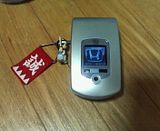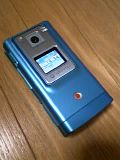My personal phone is a Sony Ericsson A1404SII. The link is to a Japanese page, but there is plenty of Flash eye candy (Firefox users who are running the excellent Adblock extension, just click on the "Play button"--I promise the Flash is not nasty).
 The most interesting thing to do is probably to click on first little image on the left under the main pane (it looks like the image to the right
The most interesting thing to do is probably to click on first little image on the left under the main pane (it looks like the image to the right ): it will pop up a window in which a Flash movie extolling the virtues of the phone will be displayed. Clicking on "DESIGN" will show you close-up images of the phone--mine is the light blue one in the first few pictures--if you click on the thumbnails at the top--and clicking on "USEFUL" will give you information on some of the phone's main features.
): it will pop up a window in which a Flash movie extolling the virtues of the phone will be displayed. Clicking on "DESIGN" will show you close-up images of the phone--mine is the light blue one in the first few pictures--if you click on the thumbnails at the top--and clicking on "USEFUL" will give you information on some of the phone's main features.Speaking of the phone's main features, for those of you who do not read Japanese, here is a run-down:
- Digital camera -

 Like all Japanese phones these days--you literally cannot find one without anymore--my keitai has a built-in digital camera! It can actually be set to 640x480 resolution, which makes it almost a digital camera replacement (but not quite, since the camera is probably not quite even 1 megapixel). The phone has a reasonably large amount of memory, so you can save quite a few photos on it, and it supports renaming them and slideshow mode, which is really cool. Not to mention being able to set your main display's background image to any photo (mine is pictured at left) and set a photo as the quick-display image (mine is pictured at right).
Like all Japanese phones these days--you literally cannot find one without anymore--my keitai has a built-in digital camera! It can actually be set to 640x480 resolution, which makes it almost a digital camera replacement (but not quite, since the camera is probably not quite even 1 megapixel). The phone has a reasonably large amount of memory, so you can save quite a few photos on it, and it supports renaming them and slideshow mode, which is really cool. Not to mention being able to set your main display's background image to any photo (mine is pictured at left) and set a photo as the quick-display image (mine is pictured at right). - C-mail - C-mail is what my mobile carrier, au, calls their version of SMS that works only with other au customers. Which is fine by me, because both Lyani and Ota have au phones.
- E-mail - Yes, just like most American phones these days, all Japanese phones have email capabilities. This is how I accomplished my moblogging on the train the other night. The best part about the emailing support is that you can attach photos that you have taken with the built-in camera, so you can get your photos to your computer even if you have been too lazy to setup Linux-IrDA! :)
- Address book - OK, this is pretty standard, but since everyone in Japan has camera phones, you can attach photos to address book entries, so when your phone rings, the quick-display literally shows you who is calling! Nice! Of course, there is tight email and C-mail integration, and if you have a GPS-capable phone, I bet you can even tie a GPS map to a contact.
- Web browser - Again, most mobile phones these days have this. Luckily, the browser that au provides with EZweb (which was actually developed by Openwave, for whom my friend Michael Smith works) works just fine with Google and IMDb, so Lyani and I can resolve almost any factual dispute, even while walking around in Motomachi. ;)
- Etceterata - And of course, my phone has all of the standard applications and utilities, including a schedule manager, a calculator, games, downloadable ring tones (even animated ones!), games, and so on.
My work phone is a
 Vodafone 802N (made by NEC). I have the blue one that is prominently pictured on that page. It can basically do everything that my personal phone can (but its camera--despite cracking the 1 megapixel barrier--can only go up to 352x288 in resolution, sadly), and has a few extra features, to boot. Peruse the following list to see what they are (have you ever been reading a webpage and gotten the sneaking suspicion that some of the text is just there to make sure images are laid out correctly on the page?). Here is the list (OK, I think that is enough textual padding):
Vodafone 802N (made by NEC). I have the blue one that is prominently pictured on that page. It can basically do everything that my personal phone can (but its camera--despite cracking the 1 megapixel barrier--can only go up to 352x288 in resolution, sadly), and has a few extra features, to boot. Peruse the following list to see what they are (have you ever been reading a webpage and gotten the sneaking suspicion that some of the text is just there to make sure images are laid out correctly on the page?). Here is the list (OK, I think that is enough textual padding):- miniSD - Yes, the 802N supports plugging a miniSD card right into it! This means that I should be able to transform my phone into the ultimate commuting multimedia device, once I figure out how to encode audio and video in a format that the phone will play (and the Unix / Linux platform provides great tools for this kind of byte-level reverse engineering!). Then, I should be able to listen to music and interesting podcasts (there, Wil Wheaton, I have plugged you about 500 times today!), and watch episodes of "The Wire" on the train! :)
- Front camera -

 In addition to the standard camera on the back of the phone, the 802N also has a front camera, i.e. one that faces you while you are talking on the phone. This allows the phone to be used as a videophone (see images left and right)! While this is not quite as Earth-shattering as implications of Skype videotelephony, it is still a pretty cool feature!
In addition to the standard camera on the back of the phone, the 802N also has a front camera, i.e. one that faces you while you are talking on the phone. This allows the phone to be used as a videophone (see images left and right)! While this is not quite as Earth-shattering as implications of Skype videotelephony, it is still a pretty cool feature!
And there you have it. Happy you asked, Sean? ;)

No comments:
Post a Comment